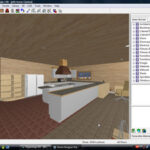Designing a vacant room in the house as a home movie theater is not just about applying knowledge in interior design. To maximize the cinema experience at the comfort of your own home, building it also requires knowledge on the basics of audio-video systems, lighting, sound proofing and electrical connections. Given your specific resources, how can you make the best investment?
Steps:
Step 1
Make an initial layout to help you decide where to effectively place your home theater equipment and furniture (whether you are still in the process of buying them or they are already available to you). Consider the size and acoustical properties of the room, whether using a projection system or a large screen TV (preferably HD TV), whether in-wall or standalone speakers would suit the location, how the cables and power outlets will be connected and where the audience will sit in relation to the screen.
If seriously investing for a premier home movie theater, it is best to work with a professional to design the space to get the technical requirements right: the proper height of the screen, the proper distances of the seats, the soundproofing requirements of the room and the best entertainment systems available for your budget.
Step 2
Complete the equipment and furniture for your home movie theater. It is best to invest in widescreen HD TV, whether TV with an LCD or plasma screen, instead of the narrower full screen TV. Options for having a projector and white screen may be considered, but this doesn’t provide the quality an HD TV gives in terms of high definition visuals-unless your room is fully equipped with an HD projector (which is highly unlikely because its price is meant for commercial movie theaters) or a 35mm film (which requires no Blu-ray discs nor DVDs but the actual 35mm prints used in standard commercial theaters).
Buy the lighting and audio requirements you need. You may want to invest in lighting systems with dimmers and soundproofing materials for a more theater-like atmosphere. Buy the storage furniture you need for all your equipment and for your discs.
Step 3
Soundproof the room by placing sound-dampening materials like acoustic fabrics on the walls and ceilings, then put thick carpet on the floor. The door can cause sound leak which may be filtered by adding special sound isolation cover like weather-stripping material around the door’s contours. If you can choose a specific door for your home theater, an exterior-grade garage door is the best choice.
It’s best to choose a flat, no-glare dark paint for the room’s walls and ceiling and place thick, dark curtain on the windows. Never use a gloss, semi-gloss or satin finish that may cause screen glare. As the walls and ceiling should not put distraction to the room’s focal point which is the video screen, use black or anything very dark and matte for them.
Step 4
Follow your layout as you place the furniture and lights. Like the quality equipment, dark surroundings and proper acoustics, lighting set-up is crucial to the overall quality of your home movie theater. Light sources and its directivity should provide just enough illumination so people can move around safely. It must not cast any glare on the screen. It’s good to invest on track lighting which allows you to aim and focus the light. One inexpensive way to conveniently adjust the level of light in the room is by installing dimmers. Avoid using table lamps and fluorescents as they tend to flood the room with light and cast glares on reflective materials.
The furniture for the entertainment system and the storage cabinet for Blu-rays and DVDs are usually painted in black so as to keep the focus on the screen. Never use metallic or anything shiny. Media storage areas should either be on the far side, outside people’s viewing position, or at the back.
Sofa sets and small table placements depend on the location of your screen.
Step 5
Put your entertainment system (which may include the TV, Blu-ray or DVD player and speakers) on the equipment rack, then run the cables behind the walls and arrange the connections. You may need to drill holes and use studs to run electrical, audio, video and other cables. Put extension cords (preferably black), if needed.
Depending on the speakers you own, place them around the room or attach them to the walls according to the specifications in the manual. The speaker placement is affected by the layout of other things in the room, primarily the location of the screen and the seats. Balance the sound with a right speaker, left speaker and a center speaker. High end audio systems may employ more speakers.
Step 6
Plug the cords, open your entertainment system and have a test viewing. Fix the audio and video settings as needed. Once everything is set, put the rest of your Blu-ray and DVD collection on the storage media cabinet.
“Your Script to Building the Ultimate Home Theater Experience.” Your Home Theater Design.
“Home Theater.” Hometime Now.
“Enhancing a Home Theater Experience.” DIY Network.






